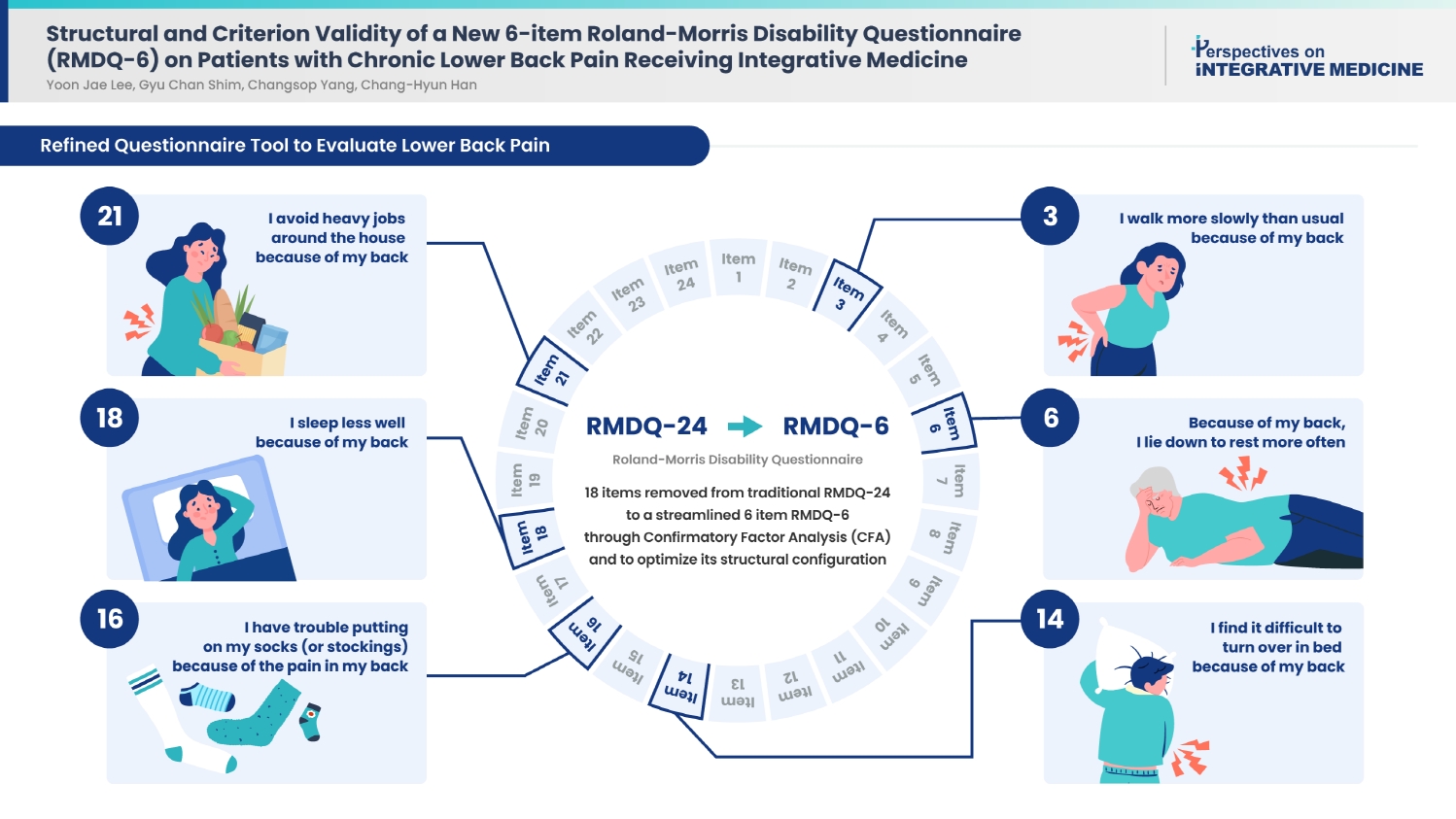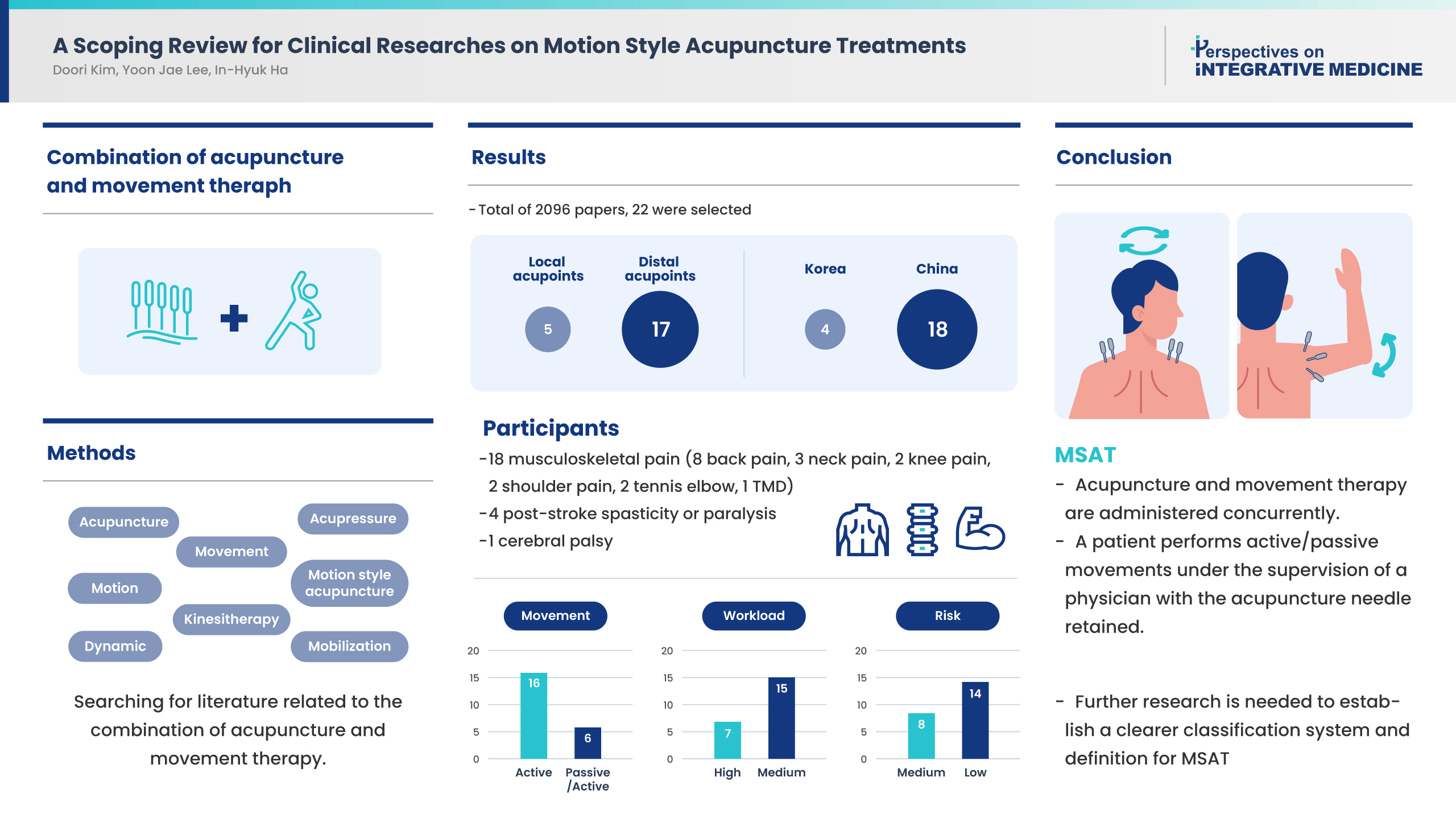Search
- Page Path
- HOME > Search
Original Article
- Structural and Criterion Validity of a New 6-item Roland–Morris Disability Questionnaire (RMDQ-6) on Patients with Chronic Lower Back Pain Receiving Integrative Medicine
- Yoon Jae Lee, Gyu Chan Shim, Changsop Yang, Chang-Hyun Han
- Perspect Integr Med. 2023;2(3):182-189. Published online October 23, 2023
- DOI: https://doi.org/10.56986/pim.2023.10.006
- 578 View
- 17 Download
-
 Graphical Abstract
Graphical Abstract
 Abstract
Abstract
 PDF
PDF Supplementary Material
Supplementary Material 
- Background
Lower back pain (LBP) is a leading cause of disability worldwide. The Roland–Morris Disability Questionnaire (RMDQ) has been widely used to assess functional impairment in patients with LBP. However, its length and redundancy calls for a more concise and optimized version.
Methods
We conducted a secondary analysis of data from two randomized controlled trials comparing pharmacopuncture and physical therapy for chronic LBP. We focused on 132 patients with moderate-to-severe symptoms and analyzed their baseline data to evaluate the structural validity of the RMDQ. We used R packages lavaan and semPlot for confirmatory factor analysis (CFA). Model fit were assessed through various indices, including comparative fit index, Tucker–Lewis index, root mean square error of approximation, and standardized root mean squared residual.
Results
A total of 18 items were ultimately removed to produce a streamlined 6-item structure. Our model met the fit index criteria, yielding a one-domain, 6-item RMDQ structure. While the relative indices fell slightly short of the ideal values, the RMDQ-6 derived through CFA correlated well with the original version.
Conclusion
This study developed a more concise version of RMDQ through CFA to optimize its structural configuration. This concise instrument can be proposed as an efficient tool to assess the functionality of patients with LBP.
Review Articles
- Minimum Clinically Important Difference for Nonsurgical Interventions for Spinal Diseases: Choosing the Appropriate Values for an Integrative Medical Approach
- Ye-Seul Lee, Sungmin Lee, Yoon Jae Lee, In-Hyuk Ha
- Perspect Integr Med. 2023;2(2):86-99. Published online June 23, 2023
- DOI: https://doi.org/10.56986/pim.2023.06.003
- 696 View
- 25 Download
-
 Graphical Abstract
Graphical Abstract
 Abstract
Abstract
 PDF
PDF Supplementary Material
Supplementary Material 
- The minimal clinically important difference (MCID) plays a crucial role in the design and interpretation of clinical trials, as it helps in distinguishing between statistically significant and clinically meaningful outcomes. This scoping review aims to collate and appraise the current research concerning the validation of MCIDs for surgical and nonsurgical measures for spine disorders. Two databases of MEDLINE (PubMed and EMBASE) were searched. There were 1,590 studies retrieved and 79 were selected as eligible for review. Measurement tools such as the Oswestry Disability Index, Neck Disability Index, Numeric Rating Scale, and Visual Analogue Scale were assessed by regions and interventions. A total of 24 studies identified MCIDs on nonsurgical interventions, and 55 studies identified MCIDs on surgical interventions. The range of MCIDs varied greatly depending on study population, specific interventions, calculation methods, and outcomes. This scoping review emphasizes the complexity and variability in determining MCIDs for musculoskeletal or neurodegenerative spinal diseases, influenced by several factors including the intervention type, measurement tool, patient characteristics, and disease severity. Given the wide range of reported MCIDs, it is crucial to consider the specific context when interpreting these values in clinical and research settings. To select an appropriate MCID value for comparison in a clinical trial, careful consideration of the patient group, intervention, assessment tools, and primary outcomes is necessary to ensure that the chosen MCID aligns with the research question at hand.
- A Scoping Review of Clinical Research on Motion Style Acupuncture Treatment
- Doori Kim, Yoon Jae Lee, In-Hyuk Ha
- Perspect Integr Med. 2023;2(2):65-76. Published online June 23, 2023
- DOI: https://doi.org/10.56986/pim.2023.06.001
- 1,343 View
- 39 Download
- 2 Citations
-
 Graphical Abstract
Graphical Abstract
 Abstract
Abstract
 PDF
PDF 
- This scoping review was conducted to examine the concept of Motion style acupuncture treatment (MSAT), use in clinical practice, its effectiveness, and safety. A literature review of clinical study treatment methods combining acupuncture and movement therapy was performed using PubMed. Of 2,096 studies retrieved, 22 were included in this review. There were 12 randomized controlled trials, and all 22 studies were published in China and Korea, mostly, within the last 3 years. There were five studies concerning local acupoints and 17 studies regarding needling at distal acupoints, and the level of risk of the procedure was “high” in eight studies and “moderate” in 14 studies. The study participants were patients with musculoskeletal pain, and many studies reported significant improvements in pain and functional disability outcomes following treatment using MSAT. For conclusion, MSAT refers to a treatment method in which a patient performs active/passive movements under the supervision of a physician with the acupuncture needle retained at the insertion site. However, there are a limited number of MSAT studies, and various treatment types and related terms are mixed. Further studies, classification of the types of MSAT using a well-established classification system, and a clearer definition of the MSAT concept are needed.
-
Citations
Citations to this article as recorded by- Effectiveness of lumbar motion style acupuncture treatment on inpatients with acute low back pain: A pragmatic, randomized controlled trial
Oh-Bin Kwon, Dong Wook Hwang, Dong-Hyeob Kang, Sang-Joon Yoo, Do-Hoon Lee, Minjin Kwon, Seon-Woo Jang, Hyun-Woo Cho, Sang Don Kim, Kyong Sun Park, Eun-San Kim, Yoon Jae Lee, Doori Kim, In-Hyuk Ha
Complementary Therapies in Medicine.2024; 82: 103035. CrossRef - Effectiveness and Safety of Progressive Loading–Motion Style Acupuncture Treatment for Acute Low Back Pain after Traffic Accidents: A Randomized Controlled Trial
Seung-Yoon Hwangbo, Young-Jun Kim, Dong Guk Shin, Sang-Joon An, Hyunjin Choi, Yeonsun Lee, Yoon Jae Lee, Ju Yeon Kim, In-Hyuk Ha
Healthcare.2023; 11(22): 2939. CrossRef
- Effectiveness of lumbar motion style acupuncture treatment on inpatients with acute low back pain: A pragmatic, randomized controlled trial
- Clinical Research on Pharmacopuncture in Korea: A Scoping Review
- Me-riong Kim, Seong Min Lee, Yoon Jae Lee, In-Hyuk Ha
- Perspect Integr Med. 2023;2(1):8-23. Published online February 21, 2023
- DOI: https://doi.org/10.56986/pim.2023.02.003
- 1,954 View
- 64 Download
- 7 Citations
-
 Graphical Abstract
Graphical Abstract
 Abstract
Abstract
 PDF
PDF Supplementary Material
Supplementary Material 
- This scoping review was performed as an update on the effects and safety of pharmacopuncture clinical research for the treatment of multiple indications in Korea. Nine electronic databases were searched to identify comparative clinical studies and clinical practice guidelines on Korean pharmacopuncture from inception to December 31, 2022. In vivo and in vitro studies, and case reports were excluded. There were 226 studies identified, including randomized controlled trials, retrospective comparison observational studies, and single-subject crossover designs, of which 17 focused on clinical safety profiles. Most studies pertained to rehabilitation medicine, especially for musculoskeletal (n = 129) and nervous system disorders (n = 35). The evidence supported treatment of neoplasms, obesity, and stroke sequelae. Adverse events of pharmacopuncture were mostly mild and temporary, and occurred more frequently with bee venom compared with herb-derived solutions. Thirty-five clinical practice guidelines including recommendations on pharmacopuncture were included. To the best of our knowledge, this is the first scoping review of clinical pharmacopuncture use in Korea, and our findings support its use in clinical practice and research. Considering the diverse clinical applications of pharmacopuncture, additional pragmatic trials are required to further strengthen the evidence base and develop standard research methodology in Korean medicine.
-
Citations
Citations to this article as recorded by- The effect of integrative Korean medicine treatment on symptomatic lumbar facet joint cysts: A case series
Hee-seung Choi, Yoon Jae Lee, Dae-Hyun Hahm, Hyangsook Lee, In-Hyuk Ha
EXPLORE.2024; 20(1): 130. CrossRef - Long-Term Follow-Up of Inpatients with Rotator Cuff Tear Who Received Integrative Korean Medicine Treatment: A Retrospective Analysis and Questionnaire Survey
Dong-Hwi Yoo, Jae-Yong Choi, Sang-Gun Lee, Ki-Won Choi, Han-Bin Park, Ho Kim, Hyunwoo Cho, Sang Don Kim, Doori Kim, Yoon Jae Lee, Kyoung Sun Park, In-Hyuk Ha
EXPLORE.2024; 20(2): 212. CrossRef - Long-term follow-up of inpatients with meniscus tears who received integrative Korean medicine treatment: A retrospective analysis and follow-up survey
June Haeng Lee, Jin Young Song, Kyoung Sun Park, Jinho Lee, In-Hyuk Ha, Yoon Jae Lee
Medicine.2024; 103(6): e36917. CrossRef - Effectiveness of lumbar motion style acupuncture treatment on inpatients with acute low back pain: A pragmatic, randomized controlled trial
Oh-Bin Kwon, Dong Wook Hwang, Dong-Hyeob Kang, Sang-Joon Yoo, Do-Hoon Lee, Minjin Kwon, Seon-Woo Jang, Hyun-Woo Cho, Sang Don Kim, Kyong Sun Park, Eun-San Kim, Yoon Jae Lee, Doori Kim, In-Hyuk Ha
Complementary Therapies in Medicine.2024; 82: 103035. CrossRef - Survey on the current usage of ultrasound-guided procedures in Korean Medicine Clinics and Hospitals
Ju Yeon Kim, Jung Min Yun, Sook-Hyun Lee, Yoon Jae Lee, Dong Kun Ko, In Heo, Woo-Chul Shin, Jae-Heung Cho, Byung-Kwan Seo, In-Hyuk Ha
Medicine.2024; 103(14): e37659. CrossRef - A Pragmatic Randomized Controlled Trial on the Effectiveness and Safety of Pharmacopuncture for Chronic Lower Back Pain
Kyoung Sun Park, Changnyun Kim, Joo Won Kim, Sang‐Don Kim, Jee Young Lee, Yoon Jae Lee, Jinho Lee, Min Ji Kim, Young Eun Choi, Changsop Yang, Chang-Hyun Han, In-Hyuk Ha
Journal of Pain Research.2023; Volume 16: 2697. CrossRef - Domestic Clinical Research Trends of Shinbaro Pharmacopuncture: Scoping Review
Yeongmin Kim, Yunhee Han, Seungkwan Choi, Jungho Jo, Byeonghyeon Jeon, Hyeonjun Woo, Wonbae Ha, Junghan Lee
Journal of Korean Medicine Rehabilitation.2023; 33(4): 125. CrossRef
- The effect of integrative Korean medicine treatment on symptomatic lumbar facet joint cysts: A case series



 First
First Prev
Prev


